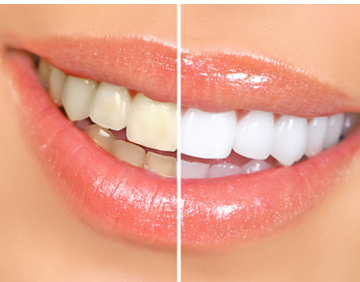Who would not want a beautiful dazzling smile with sparkling white teeth? Well, one of the latest and the most common procedures in Cosmetic Dentistry known as tooth whitening (tooth bleaching) can help you achieve that! Continuing with my smile designing series, I would be explaining in brief all you would want to know about cosmetic teeth whitening. WHAT IS TOOTH BLEACHING? According to FDA, teeth bleaching is permitted to be used only when teeth can be whitened beyond its natural color. . Majority of us start with decently white teeth .The tooth crown structure, as you know, consists of the outermost white layer known as enamel, the middle yellowish layer known as dentin and the innermost core known as the pulp (nerve) of the tooth. Over period of years, the enamel starts wearing out, there are micro cracks developing due to biting and chewing forces and food debris and stains get lodged between them. Also, the yellow dentin below the now thin enamel gives the tooth an overall yellowish hue. Cosmetic tooth bleaching will help out removing the stains from the micro cracks in enamel, which later get mineralized due to saliva. INDICATIONS FOR TOOTH WHITENING: To remove extrinsic stains present on the teeth as a result of exposure to food, dark colored beverages, tobacco, smoking and normal wear and tear of teeth. Although difficult to remove bleaching may be successful in cases of intrinsic stains caused due to trauma, tetracycline ingestion during tooth formation stage and high concentration of fluoride intake. CONTRAINDICATIONS FOR TEETH WHITENING: Pregnant and nursing mothers. Hypersensitive teeth, receding gums and defective fillings need a complete evaluation prior to bleach. People who are sensitive to hydrogen peroxide gel. Children under 16 years of age are not indicated for bleaching. EVALUATION BEFORE TOOTH BLEACHING: The dentist needs to evaluate the teeth completely before bleaching and take a complete medical history to avoid any allergies and sensitivities along with the routine X-rays. TYPES OF TOOTH WHITENING: IN-OFFICE BLEACHING: This is one of the most convenient and the fastest way to bleach your teeth at the dentist’s office. It gives you significant color results and is one of the best forms of bleaching. In this, mainly the teeth that are seen, when you smile or talk, are bleached. Procedure: Firstly the current shade of the tooth is taken by the dentist by a Vita pan Classic shade guide just to compare it with the post bleaching results. Also, bleaching will only result in a few shades lighter than the existing tooth shade. A light cured gingival barrier is applied to gums to protect the soft tissues and papillae along with a cheek retractor in place. The teeth to be bleached are dried and isolated completely. High concentration light activated bleaching gel which contains 25-38% hydrogen peroxide is carefully applied on tooth surface thereby avoiding any sort of chemical burn to the adjacent soft tissues. The light energy used to activate the bleaching layer can be laser, halogen, LED or plasma arc. Halogen light is the most commonly used. Bleaching gel is exposed to the light source for 6-15 mins which will initiate the hydrogen peroxide reaction after which it is rinsed off. Reapplication of this gel is dependent on the condition of the patient’s teeth. The total procedure would last for 30mins-1 hour in a dental office. In office bleaching can be followed by home bleaching depending on patient’s requirements. Patient is asked to avoid any stained foods or dark colored beverages for at least a week post bleaching. It is ideal to wait for 2 weeks before the final color of the teeth post bleaching can be assessed. HOME BLEACHING: This involves a take over home bleaching kit which contains a lower concentration carbamide peroxide gel along with custom made bleaching trays which are specifically made for the patient by taking an impression of the teeth in the first appointment. The gel is applied on the tray and the patient wears it like a mouth guard for about 1 hour at least (sometimes overnight too) depending on the concentration of the gel. The procedure is repeated every alternate days and treatment time varies from patient to patient but is roughly around 6 – 15 days. INTERNAL BLEACHING: Also referred to as ‘Walking Bleach’ technique, it is only indicated for root canal treated teeth that have undergone endodontic therapy and are discolored as a result of it. It is recommended for front teeth a hole is drilled in the pulp chamber and peroxide gel is placed in the tooth and sealed up. The tooth is kept under observation for a few days after which the gel may be rinsed or the procedure may be repeated. This procedure helps in removing blood stains and debris from dentine which get lodged there during the process of root canal treatment. A large number of other whitening products such as whitening kits involving bleaching strips or gels with one-size-that-fits-all mouth trays, chewing gums or whitening tooth pastes are available in the market which uses very low concentration of bleaching gel. DISADVANTAGES OF TEETH BLEACHING: Tissue irritation and sensitive teeth is the most common side effect of bleaching due to chemical burn to soft tissues from bleach or ill fitting mouthpiece. It is however temporary and subsides within 1-3 days. Over bleached teeth. Bleaching does not change the color of ceramic restorations. However, it is known to remove the stains over composite fillings caused due to food and habits of the patient. To, avoid the Technicolor effect, these restorations need to be changed post bleaching.

